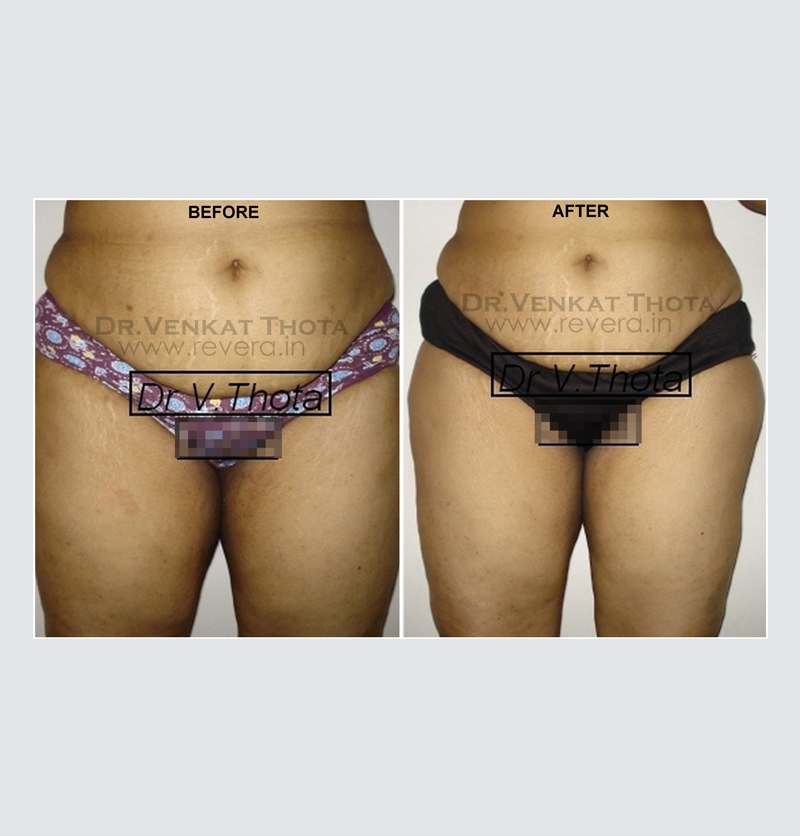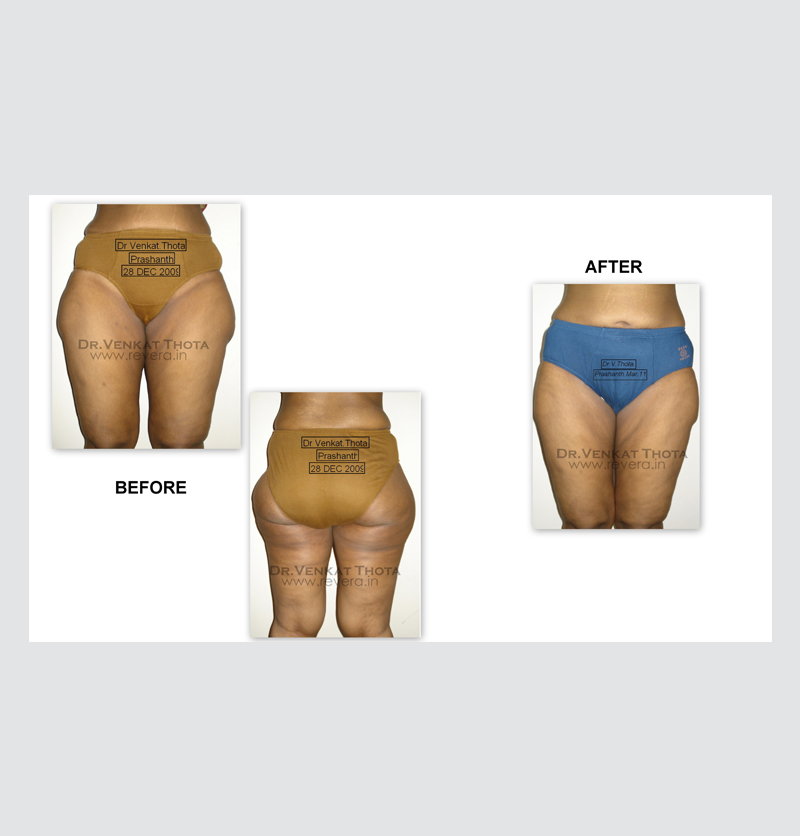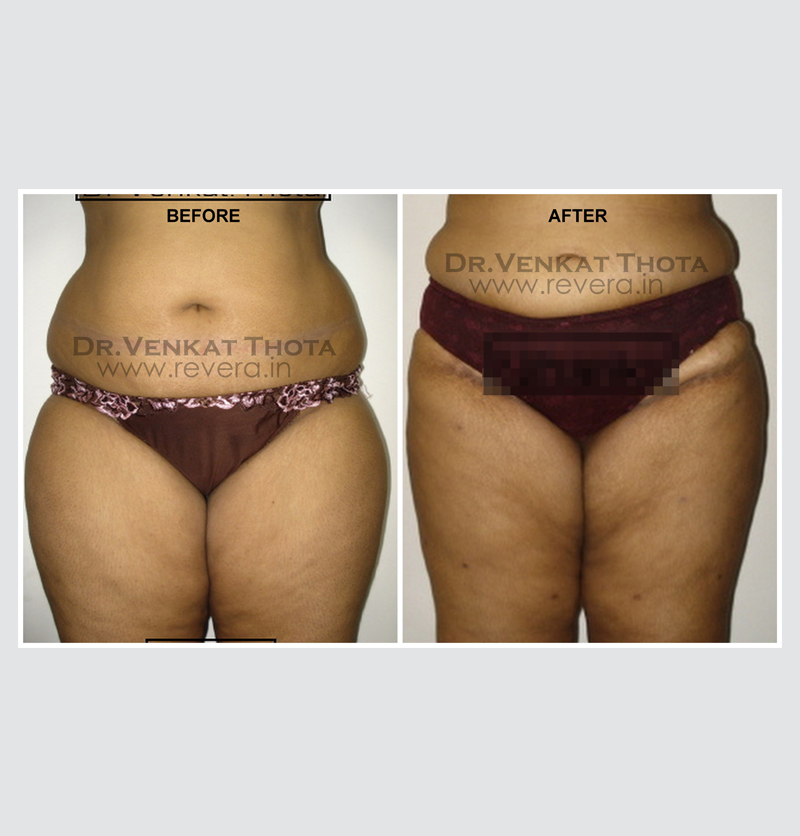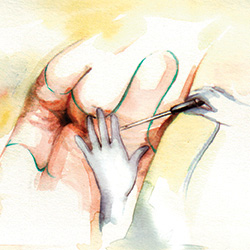ABOUT
Also known as lipoplasty and body contouring surgery
Some people have pockets of fat accumulation in certain parts of the body which are resistant to diet and exercise. These are usually seen in
- Buttocks
- Hips
- Love handles
- Saddlebags
- Thighs
- Calves
- Ankles
- Breasts (including male breasts)
- Back
- Arms and neck
Liposuction surgery helps eliminate these pockets of fat, thus helping in sculpting your body. It is also usually combined with few other procedure to get the desired result.
PHOTO GALLERY



RELATED PROCEDURES
Many people who consider liposuction also consider a tummy tuck, a mommy makeover and nonsurgical skin tightening.
| WHERE IS IT DONE |
|---|
| Operation Theatre |
| DURATION |
|---|
| 1-4 Hours |
ANAESTHESIA
Local Anaesthesia Or Spinal Anaesthesia Or General Anaesthesia
INCISIONS, STITCHES & SCARS
- As small incisions are used, the resulting scars are also small and barely visible.
- The surgeon strategically plans and places the incisions and stitches for the surgery in terms of number, size, material, location and technique aiming to keep the resulting scar minimal, hidden and not easily visible eye. Special tissue handling and suture techniques further minimize scars.
| STAY AT CLINIC |
|---|
| 24-48 Hours |
HOW IS IT PERFORMED?
Fat from your body removed by using suction. In this procedure small, thin, blunt-tipped tubes (cannula) are inserted through small cuts in the skin. The plastic surgeon moves these tubes under the skin targeting the fat deposits and then suctions them out.
Suction-assisted liposuction (SAL), this the most traditional form of, it draws fat out with a vacuum.
It is done in 3 steps
- Separation – Unwanted fat cells are loosened, emulsified and separated out without generating heat, so that essential blood vessels, skin and other tissues are not traumatized.
- Aspiration – Through careful and skilled suction fat cells are gently removed, without damaging supporting structures such as nerves, blood vessels, skin.
- Fat Equalization –the remaining thin fat layer is smoothened out, thus leaving behind a uniform layer of ‘local fat grafts’. This step prevents the formation of contour deformities.
Dressings will be applied after the procedure and you will be needed to wear compression garments for a specific period of time.
Liposuction is a procedure to remove fat from your body, various techniques can be employed for the same. Some are new and some are old. “Suction Assisted Liposuction” has been is use since many decades. Some techniques are relatively new and enough evidence is not really available yet to support their safety and efficacy. Choosing a procedure based on “the trend” and “the new one” is never a medically sound decision. It is very high importance that you know the advantages and disadvantages with each technique. Just because you hear about a technique or a product in print and online media, doesn’t necessarily mean that it is the right option for you. Our plastic surgeon based on his experience, your health status, body type and your cosmetic goals will recommend the best options for you. Make a wise decision.
 The surgeon will diagram treatment areas like the hips, abdomen, thighs and flanks.
The surgeon will diagram treatment areas like the hips, abdomen, thighs and flanks.
 A cannula is inserted through a small incision and fat carried away with suction.
A cannula is inserted through a small incision and fat carried away with suction.
 Liposuction helps eliminate unsightly bulges by removing localized fat deposits.
Liposuction helps eliminate unsightly bulges by removing localized fat deposits.
 It is important to maintain a healthy lifestyle with diet and exercise to prolong results.
It is important to maintain a healthy lifestyle with diet and exercise to prolong results.
| REST AT HOME BEFORE RESUMING OFFICE WORK |
|---|
| 1 Week |
AFTERCARE AND RECOVERY
- Patients can return to their work routine within a few days after the surgery.
- Suture removal: 7-10 days after the surgery.
- Removal of drains if placed will be removed 4-6 days after the surgery.
- Avoid sunbathing and exposing the treated area to direct sunlight for at least 4-6 weeks, as it may trigger swelling.
- Avoid: Aspirin, anti-inflammatory medication, Smoking, Alcohol consumption for at least 10 days before and after the surgery.
- Make a gradual effort, rather than a sudden attempt to get back to your daily routine.
- You start going to the gym and playing sports after 3 months, but increase your work out intensity gradually.
- Discomfort due to soreness can be felt after the surgery, for the first few days, this can be relieved with pain medication.
Swelling will be present maximally for the first 48 hours after that it gradually disappears over the next two to three weeks. A slight residual swelling can be present for upto 4 months.
Bruising is normal with liposuction and it usually disappears within seven to ten days.
Long-term Recovery
Healing is a gradual process and you should be patient and wait for at least several months to see the accurate results of the surgery. The small incision marks would gradually fade over several months and eventually would become had to notice.
| FOLLOW UP VISITS |
|---|
| 1 Week, 3 Weeks, 2 Months, 4 Months, 8 Months from the Date of the Surgery. |
HOW LONG WILL MY RESULTS LAST?
The results yielded by the liposuction surgery are technically permanent as the surgeon removes the fat cells from the target area. However, few fat cells would still be left. If you take an excess calorie intake, it will be converted to fat and deposited in the body. Where exactly, it gets deposited is hard to predict. But the remaining fat cells would still have the propensity to increase in size. Further your body shape and contours can be affected by lifestyle factors, ageing, pregnancy and hereditary factors. Hence to maintain the results, for a long time, it is important that you keep your weigh stable.
Maintain good communication with the aesthetic plastic surgeon
Keeping safety in mind as well as for the most beautiful outcome of the procedure, we advise that you visit the clinic for follow-up and evaluation at prescribed times. Also do not hesitate to contact the doctor if you notice any changes in the treatment areas or when you have any concerns and queries.
ASSOCIATED COSTS
Click here for the cost for Breast Reduction.
LIMITATIONS & RISKS
Significant complications from Breast Reduction, fortunately, are infrequent. The risks specific to your health will be discussed during the consultation. Thousands of women undergo this procedure every year and are glad with the results.
Every surgery has some risks associated with it. Some potential ones include
- Allergies
- Adverse response to the specific med
- Damage to the underlying structures during the procedure
- Hematoma or seroma (an aggregation of blood or liquid under the skin that might require removal)
- Infection and bleeding
- Changes in sensation
- Scarring
- Unsatisfactory results that might necessitate additional procedures
Some risks specific to liposuction include
- Irregularities in contour
- Indentations
You can minimize certain risks by following the instructions given by the doctor both before and after the surgery.
